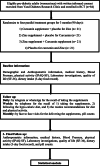Evaluation of the effect of curcumin and zinc co-supplementation on glycemic measurements, lipid profiles, and inflammatory and antioxidant biomarkers in overweight or obese prediabetic patients: a study protocol for a randomized double-blind placebo-controlled phase 2 clinical trial
- PMID: 33256795
- PMCID: PMC7708225
- DOI: 10.1186/s13063-020-04923-w
Evaluation of the effect of curcumin and zinc co-supplementation on glycemic measurements, lipid profiles, and inflammatory and antioxidant biomarkers in overweight or obese prediabetic patients: a study protocol for a randomized double-blind placebo-controlled phase 2 clinical trial
Abstract
Background: The prevalence of prediabetes is increasing worldwide. Unfortunately, prediabetes is related to non-communicable diseases. A high risk of developing type 2 diabetes mellitus (T2DM) is reported in people with prediabetes. Curcumin, a polyphenol, might lead to its therapeutic role in obesity and some obesity-related metabolic diseases. Zinc is a trace element that plays a key role in the synthesis and action of insulin, carbohydrate metabolism, and decreasing inflammation. There has been no clinical trial of zinc and curcumin co-supplementation in patients with prediabetes. In previous studies, the single administration of zinc or curcumin has not been conducted on many of the studied markers in prediabetic patients.
Methods: The purpose of this randomized double-blind placebo-controlled clinical trial is to investigate the effect of curcumin and zinc co-supplementation on glycemic measurements, lipid profiles, and inflammatory and antioxidant biomarkers among 84 prediabetic patients with body mass index (BMI) between 25 and 35. Also, liver enzyme, serum zinc, urine zinc, blood pressure, anthropometric parameters, quality of life, adherence to co-supplementation, the side effects of co-supplementation, physical activity, and dietary intake will be assessed. Women or men (18-50 years old for men and 18 years to before menopause for women) will be followed for 3 months (90 days). This study will be conducted at Yazd Diabetes Research Clinic, Shahid Sadoughi University of Medical Sciences.
Discussion: A diet rich in antioxidants, polyphenols, and phytochemicals has been shown to have a beneficial role in prediabetes. According to the beneficial properties of curcumin or zinc and inadequate evidence, RCTs are needed to assess the effect of curcumin and zinc co-supplementation in native prediabetes patients. We hope the results of the present trial, negative or positive, fill this gap in the literature and facilitate the approach for a much larger, multi-center clinical trial. In conclusion, a synergic effect of co-supplementation along with a weight-loss diet may delay the progression to type 2 diabetes mellitus.
Trial registration: Iranian Registry of Clinical Trials (IRCT) IRCT20190902044671N1 . Registered on 11 October 2019.
Keywords: Antioxidant biomarkers; Curcumin; Glycemic measurement; Inflammatory biomarkers; Lipid profile; Prediabetes; Randomized controlled trial; Zinc.
Conflict of interest statement
The authors declare that they have no conflict of interest.
Figures


Similar articles
-
Curcumin and zinc co-supplementation along with a loss-weight diet can improve lipid profiles in subjects with prediabetes: a multi-arm, parallel-group, randomized, double-blind placebo-controlled phase 2 clinical trial.Diabetol Metab Syndr. 2022 Jan 28;14(1):22. doi: 10.1186/s13098-022-00792-2. Diabetol Metab Syndr. 2022. PMID: 35090529 Free PMC article.
-
The effect of curcumin and zinc co-supplementation on glycemic parameters in overweight or obese prediabetic subjects: A phase 2 randomized, placebo-controlled trial with a multi-arm, parallel-group design.Phytother Res. 2021 Aug;35(8):4377-4387. doi: 10.1002/ptr.7136. Epub 2021 Apr 23. Phytother Res. 2021. PMID: 33893671 Clinical Trial.
-
Curcumin and long-chain Omega-3 polyunsaturated fatty acids for Prevention of type 2 Diabetes (COP-D): study protocol for a randomised controlled trial.Trials. 2016 Nov 29;17(1):565. doi: 10.1186/s13063-016-1702-9. Trials. 2016. PMID: 27894336 Free PMC article. Clinical Trial.
-
Inulin-type fructans supplementation improves glycemic control for the prediabetes and type 2 diabetes populations: results from a GRADE-assessed systematic review and dose-response meta-analysis of 33 randomized controlled trials.J Transl Med. 2019 Dec 5;17(1):410. doi: 10.1186/s12967-019-02159-0. J Transl Med. 2019. PMID: 31805963 Free PMC article.
-
Effects of curcumin on glycemic control and lipid profile in prediabetes and type 2 diabetes mellitus: A systematic review and meta-analysis.PLoS One. 2019 Apr 23;14(4):e0215840. doi: 10.1371/journal.pone.0215840. eCollection 2019. PLoS One. 2019. Retraction in: PLoS One. 2020 May 22;15(5):e0233919. doi: 10.1371/journal.pone.0233919. PMID: 31013312 Free PMC article. Retracted.
Cited by
-
Evaluation of the antimicrobial activity of chitosan- and curcumin-capped copper oxide nanostructures against multi-drug-resistant microorganisms.Nanoscale Adv. 2025 Mar 19;7(10):2988-3007. doi: 10.1039/d4na00955j. eCollection 2025 May 13. Nanoscale Adv. 2025. PMID: 40182310 Free PMC article.
-
Curcumin and zinc co-supplementation along with a loss-weight diet can improve lipid profiles in subjects with prediabetes: a multi-arm, parallel-group, randomized, double-blind placebo-controlled phase 2 clinical trial.Diabetol Metab Syndr. 2022 Jan 28;14(1):22. doi: 10.1186/s13098-022-00792-2. Diabetol Metab Syndr. 2022. PMID: 35090529 Free PMC article.
-
Licorice zinc suppresses melanogenesis via inhibiting the activation of P38MAPK and JNK signaling pathway in C57BL/6J mice skin.Acta Cir Bras. 2022 Dec 19;37(10):e371002. doi: 10.1590/acb371002. eCollection 2022. Acta Cir Bras. 2022. PMID: 36542040 Free PMC article.
-
Nanocurcumin combined with insulin alleviates diabetic kidney disease through P38/P53 signaling axis.J Control Release. 2023 Jan;353:621-633. doi: 10.1016/j.jconrel.2022.12.012. Epub 2022 Dec 14. J Control Release. 2023. PMID: 36503070 Free PMC article.
-
Curcumin assisted green synthesis of silver and zinc oxide nanostructures and their antibacterial activity against some clinical pathogenic multi-drug resistant bacteria.RSC Adv. 2022 Jun 28;12(28):18022-18038. doi: 10.1039/d2ra00231k. eCollection 2022 Jun 14. RSC Adv. 2022. PMID: 35874032 Free PMC article.
References
-
- Federation I . IDF diabetes atlas eighth edition. Brussels: International Diabetes Federation; 2017.
-
- International Diabetes Federation . IDF diabetes atlas. 8 2017. Chapter 1 - What is diabetes? - PubMed
-
- World Health Organization . Global report on diabetes. 2016.
Publication types
MeSH terms
Substances
LinkOut - more resources
Full Text Sources
Medical
Miscellaneous

